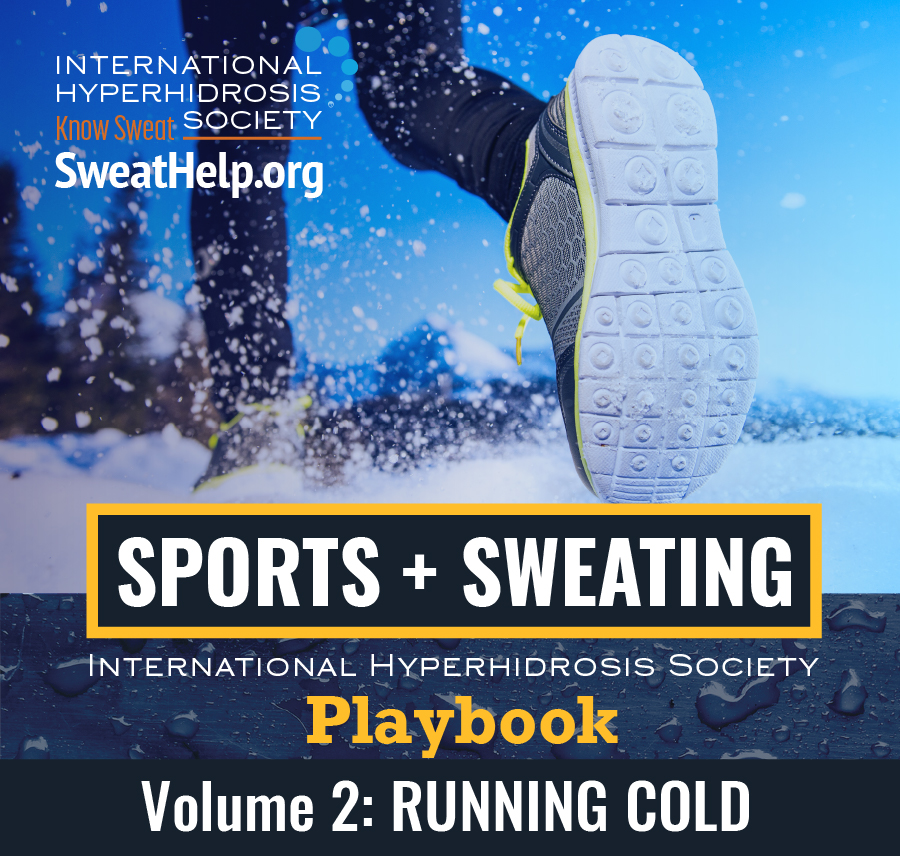

 Sports + Sweating Playbook V2: Running Cold
Sports + Sweating Playbook V2: Running Cold
Winter Workout Tips to Avoid Frostbite & Hypothermia
Welcome back to Volume 2 of the 2023 Sports + Sweating Playbook, brought to you by the champions sweating it out at the International Hyperhidrosis Society. In this second volume, we're sharing tips on how to winterize your sweat-inducing outdoor workout or activities to avoid potentially life-threatening cold-weather injuries.
The benefits of outdoor winter exercise hold true for all of us, regardless of our sweating. In fact, according to the Centers for Disease Control and Prevention (CDC), exercise:
Exercising outdoors in the cold takes preparation, no matter how much you sweat. But if you have hyperhidrosis or you just plain sweat when exercising outdoors, you need to be extra careful when it comes to winter health concerns like frostbite and hypothermia. We’ve got the info you need so that you can hit the chilly slopes or trails and pound the pavement comfortably, safely, and enjoyably.
Key Points:
Cold-Related Injuries That Should Not be Overlooked
Frostbite and hypothermia are serious winter health concerns associated with exposure to extremely cold temperatures for a prolonged period of time. Frostbite is an injury that occurs when the skin and underlying tissue below the skin freeze, and most often impacts the extremities (such as: ears, nose, cheeks, chin, fingers, and toes).
And, when sweat is involved, clothing can become damp and speed up the loss of body heat. This can put you at risk for hypothermia, a potentially life-threatening medical emergency. Backpacker magazine warns that hypothermia can be deadly even at 50°F if you’re wet. That’s right, it doesn’t actually have to be really cold out for hypothermia to strike.
❗Hypothermia can occur if a person simply becomes chilled from sweat, says the CDC.
❗Body heat is pulled from wet skin 25 times faster than from dry skin, notes the AMC.
According to the CDC, the signs and symptoms of frostbite and hypothermia are:
If frostbite or hypothermia is suspected, be sure to seek medical attention right away. In the meantime, get into a warm room or shelter and remove any wet clothing then proceed to layer on warm and dry blankets or clothing.
Prevent Frostbite and Hypothermia
To prevent frostbite and hypothermia while powering through your cold-weather workout or enjoying fun winter activities, we’ve compiled these tips to keep you safe from serious cold-weather injuries:
The Best Base Layers
If you have hyperhidrosis or expect to be working hard enough to get sweaty, your inner moisture-wicking layer is very important as it helps manage moisture (sweat) inside your clothing, which is crucial because body heat is pulled from wet skin 25 times faster than from dry skin, notes the AMC.
The best base layers for sweat management will be made of merino wool because merino insulates, wicks, and stays warm even when wet.
Polypropylene (or “polypro”) is also a common fabric used for base layers because it’s designed to wick moisture, is effective at sweat-management, breathable, and quick-drying, but - be warned - it does not stay warm when wet, so wool is often a better winter bet.
Middle Layer = Insulating Layer
Your middle layer will be your insulating layer. Often, this will be a fleece of varying thickness. The thicker the fleece or “loft”, the more insulation you can expect. A puffy jacket can also be a middle layer, but be aware that down does not retain warmth if it gets wet. For sweaty or wet conditions, synthetic-filled jackets, like those with PrimaLoft, will keep you warmer.
Outer Layers Fight the Elements & Need to Breathe
Your outer layer is your defense against rain, snow, sleet, etc. It protects you from wetness coming at you externally. But if you are sweating (excessively or not), you’ll want to make sure your outer layer is breathable, too, so that you don’t trap sweat and the resulting wetness inside while you’re keeping the precipitation outside. Fabric membranes like Gore-Tex are waterproof and breathable.
Cold Out? Get Out Anyway!
Even if you have hyperhidrosis, outdoor exercise in the winter is not only possible it’s really beneficial in many ways:
We know that excessive sweating is a huge challenge, but we’re committed to helping you stay healthy in all aspects of your life. There are treatments, products, and management techniques to help and we’re working to bring you the information you need to live your best life.
We’d love to hear how you keep outdoor exercise in your daily routine despite cold weather temps and excessive sweating. Email us at Info@SweatHelp.org
Staying and being active is critical to good health. And, well, so is sweat. Join us throughout the year as we tackle the serious challenges that come into play with sports and sweating.
Stay tuned for Volume 3 of our Sports + Sweating Playbook.
Latest Blogs